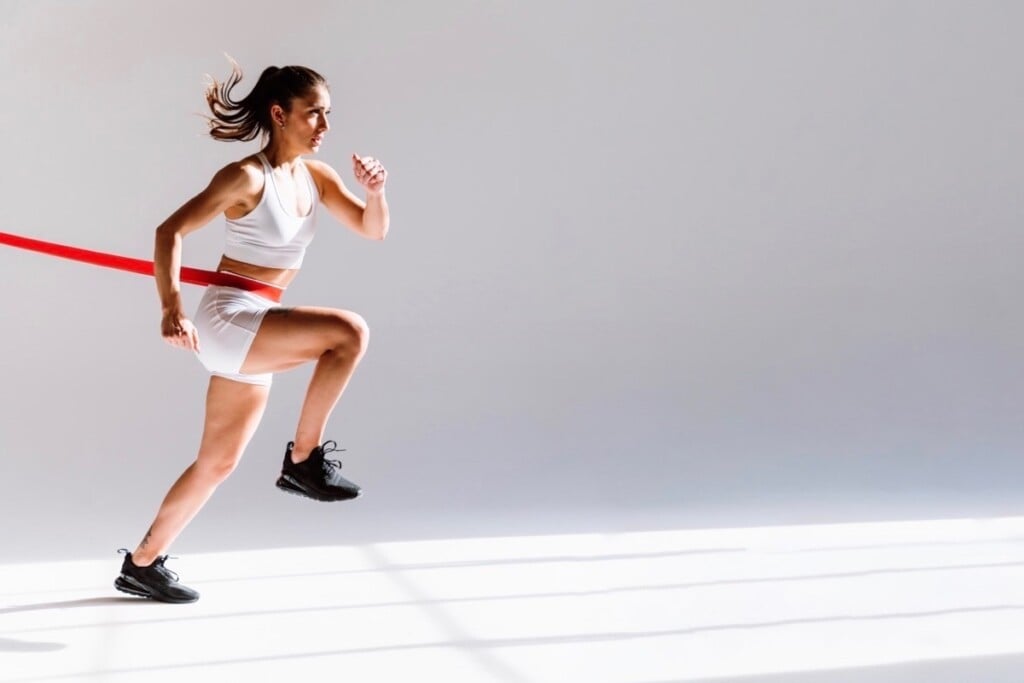The Power Of The Pull
It’s a potent, versatile workout tool that doesn’t require an app: the resistance band.

Leave it to Hollywood and sports A-listers to make a popular new craze out of a simple, low-tech exercise tool that’s been around since the 1800s. Resistance bands trace back to a Swiss inventor who designed a prototype gymnastics apparatus using stretchy ropes with clips and handles. Over the years, the bands have been used by rehabbing patients, gym enthusiasts, home workout fiends—and perhaps the occasional ripped celeb.
Today, basketball uberstar LeBron James is known to be “with the band.” When a workout video of him went public in 2013, people saw—between footage of the four-time NBA champion practicing hook shots and three-point jumpers—the way he used resistance bands while performing squats, lunges and other plyometric exercises (that is, those that involve maximum muscle exertion in short bursts of time). More than a decade later, James still reportedly uses resistance-band training as part of his workout regimen, and his physical condition is still apparently pretty good. This past summer, at 39 and the league’s all-time leading scorer, he helped the U.S. men’s basketball team win gold at the Paris Olympics. And he shares the resistance-band habit with actor Jason Momoa, actresses Halle Berry, Jessica Alba and Zendaya and others.
The design of resistance bands has improved over time, as they’ve gone from fabric contraptions to today’s latex-fabric blend, synthetic rubber or silicone. They’re also made with varying levels of tension or resistance, making them ideal for strength training, as they require a person’s force to stretch. (This distinguishes resistance-band training from TRX, total resistance exercises, or suspension training, which uses a person’s own body weight as resistance.) The Cleveland Clinic reports that a 2019 study shows that training with resistance bands provides strength gains similar to those achieved using conventional gym equipment.
“Resistance bands are a very dynamic piece of equipment,” says Enrico Fioranelli, a certified personal trainer and strength and conditioning coach at Morris Plains-based 4E Fitness. With more than 20 years’ experience in the fitness industry and a degree in exercise science, Fioranelli notes that an individual can get a total workout using resistance bands: “They can be used to work out every part of the body.”
Fioranelli also praises the bands’ accessibility. “Resistance bands tend to be a lot less expensive than a full home gym,” he says. “They are a good alternative for people who travel a lot, or cannot make it into a gym. They also tend to offer lower-impact exercise for joints while still maintaining good muscular contraction.” Low-impact exercise builds your heart rate slowly and is less likely to aggravate an existing injury or cause a new one.
According to Fioranelli, who has worked with NFL players and collegiate athletes, the full-body effect of resistance bands can do more than just produce a more sculpted physique. “Resistanceband training will help develop muscles throughout the body and, by building those muscles, help you reduce joint pain,” he says.
Resistance bands aren’t just good for that strength training— they’re good for your health too. As muscles strengthen, blood flow and pressure improve in the body, lowering the risk of heart-related ailments such as hypertension and heart disease, according to the American Council on Exercise (ACE). As Fioranelli says: “By doing total-body circuits with short rest periods, people can improve heart health.” Resistance-band training also will lead to calorie burn and a boosted metabolism, both of which can result in weight loss when combined with an appropriate diet.
Forget pumping iron—let’s stretch some rubber. Below are four quick, easy resistance band workouts anyone can try at home. “A total body circuit will optimize both burning fat and your time,” Fioranelli says. He also notes, however, that one size never fits all with fitness. “I always modify things depending on muscle imbalances and the specific needs of my client,” he says. Try these out and experiment to find what works best for you:
• Chest presses: Wrap the resistance band behind your back, holding both ends with your hands. Starting with your arms at your side and elbows bent, push the band out in front of you as you straighten your elbows, and hold for one second.
• Clamshells: Lie on your side, one leg atop the other with your knees slightly bent. Loop a resistance band around both thighs. Keeping your feet together, lift your top knee. Switch sides after each set.
• Rows: Attach the resistance band securely to a door. Holding the band with both hands, pull the band back as you bend your elbows. Keep your elbows near the side of your body.
• Squats: Stand on the resistance band and grab both ends with your hands. While standing in a squatted position and holding the band, rise up to a standing position. Lower back down and repeat.

